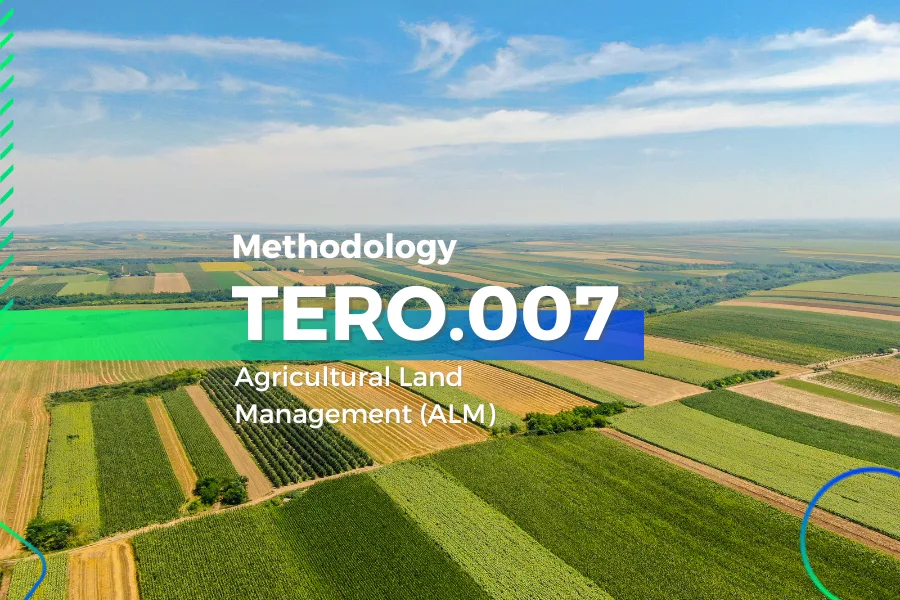TERO.007 – Agricultural Land Management (ALM) Metodology
This methodology provides the technical framework for projects that enhance carbon sequestration and reduce greenhouse gas (GHG) emissions through improved agricultural land management practices. It applies to initiatives that implement sustainable soil and crop management techniques to increase soil organic carbon (SOC) stocks and improve ecosystem resilience.
Why Choose TERO.007 – ALM?
Soil-Focused Climate Action
Specifically designed for projects that enhance carbon sequestration through soil organic matter accumulation, improved tillage practices, cover cropping, and integrated nutrient management.
Alignment with Global and National Standards
Built upon the guidelines of the IPCC, ICROA, and CORSIA, and prepared for alignment with Brazil’s SBCE (Sistema Brasileiro de Comércio de Emissões), ensuring credibility and recognition in both voluntary and regulated markets.
Permanent Environmental Benefits
Encourages agricultural systems that increase productivity while improving soil health, water retention, and biodiversity, creating long-term climate and ecosystem resilience.
Is Your Project Eligible?
This methodology applies to agricultural projects that demonstrate measurable carbon removals or emission reductions through improved management practices and that meet the following criteria:
✅ Land Tenure Compliance: The project takes place on rural properties with verified legal land tenure, following the Land Tenure Compliance Manual and Tero Carbon Seals for NBS Projects (DC.CER.002).
✅ Improved Agricultural Management: Demonstrates measurable improvements in soil management, such as reduced tillage, agroforestry integration, crop rotation, cover crops, organic amendments, or optimized fertilizer use.
✅ Socioenvironmental Co-benefits: Demonstrates at least two additional socioenvironmental co-benefits (excluding SDG 13) as defined in the Socioenvironmental Safeguards Analysis Tool (FR.CER.002).
✅ Additionality: The activities are voluntary and go beyond legal obligations or common agricultural practices, proven using the Project Additionality Demonstration Tool (FR.CER.003).
✅ Environmental Integrity: The project must comply with all applicable socioenvironmental safeguards and demonstrate that emission reductions and removals are quantifiable, verifiable, and conservative.
Methodology Application Process
Sua jornada desde a concepção até a geração de créditos segue um fluxo lógico. Cada etapa requer a aplicação de ferramentas específicas do Programa Tero para garantir a precisão e a auditabilidade.
Step 1: Baseline, Additionality, and Leakage
At this stage, the baseline scenario for soil carbon stocks is established, and it is demonstrated that the project activities go beyond conventional practices.
- Baseline: Estimate baseline soil carbon stocks (SOC) using the Technical Guidelines for Carbon Quantification in AFOLU Projects (DC.CER.003).
- Additionality: Demonstrate additionality through the FR.CER.003 Tool.
- Leakage (LK): Assess potential displacement of emissions using the Leakage Assessment and Management Tool for VCU NBS Projects (FR.CER.005).
Step 2: Quantification and Permanence Assurance
This is the core stage, where carbon removals are calculated and the safeguard mechanism is applied.
- Quantification: Use the Technical Guidelines for Carbon Quantification in AFOLU Projects (DC.CER.003) for the calculations.
- Permanence Risk and Buffer: Evaluate the Non-Permanence Risk (RNP) using the FR.CER.004 Tool and allocate a portion of VCUs to the Buffer Pool (BP).
Step 3: Monitoring and Reporting
Continuous monitoring ensures transparency and traceability throughout the crediting period.
- Carbon Monitoring: Track soil organic carbon (SOC) and relevant management indicators as described in Section 4.1 of this methodology.
- Safeguards and Co-benefits: Monitor socioenvironmental indicators using the FR.CER.002 Tool.
- Reporting: Submit a comprehensive Monitoring Report for each verification cycle following the FR.CER.007 Tool.
Essential Documentation: TERO.007 – ALM
Below you’ll find the primary document for this methodology and the associated models necessary for its implementation.
Main Document
TERO.007 – ALM, v1.0 (PT) (EN)
The complete document with all guidelines, equations, and procedures for agricultural carbon removal projects.
Developed by:
Hdom Engenharia e Projetos Ambientais Ltda
(hdom@hdom.com.br)
Centro de Energia Nuclear na Agricultura da Universidade de São Paulo (CENA – USP)
(Luiz Antonio Martinelli, martinelli@cena.usp.br)
Ferramentas e Documentos de Apoio
- FR.CER.003 – Project Additionality Demonstration Tool
- FR.CER.004 – Non-Permanence Risk and Guarantee Mechanism Tool
- FR.CER.005 – Leakage Assessment and Management Tool
- DC.CER.003 – Technical Guidelines for Carbon Quantification in AFOLU Projects (starting with version 1.2)
- FR.CER.002 – Socioenvironmental Safeguards Analysis Tool
Commitment to Transparency and Civil Society Participation
Share your Concerns or Suggestions
Do you have any concerns or suggestions about any of our registered Programs or Projects?
Submit your claims anonymously and help us continually improve.
We aim to lead the certification of Brazilian assets for the global market
Ready to learn more about our certification services or need detailed information about our service fees? Contact us today and start turning your environmental impact into value.
